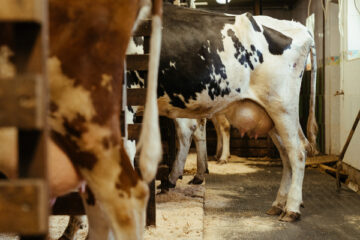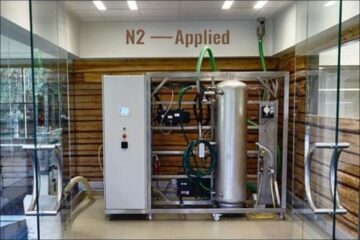Good health is essential for good welfare but they are not the same thing. An animal in good health can suffer poor welfare (although in the long-term, poor welfare will contribute to health problems).
- What steps will ensure good welfare for my cows?
- What are the benefits of ensuring good animal welfare?
- What are the major indicators of poor welfare?
What steps will ensure good welfare for my cows?
‘The five freedoms’ form a comprehensive framework for safeguarding cow welfare within the constraints of a profitable dairy industry .
- Freedom from hunger and thirst – with access to fresh
water and a diet to maintain full health and vigour. - Freedom from discomfort – an appropriate environment
including shelter and a comfortable resting area. - Freedom from pain, injury or disease – prevention or rapid
diagnosis and treatment. - Freedom to express normal behaviour – sufficient space,
proper facilities and company of the animal’s own kind. - Freedom from fear and distress – conditions and treatment
(e.g. stockmanship) which prevent mental suffering.
What are the benefits of ensuring good animal welfare?
We are ethically obliged to ensure a good standard of welfare for the animals in our care. In some cases, this will clearly be associated with a cost (e.g. providing sand or straw in addition to mattresses/mats in cubicles). However, good welfare has many benefits such as:
• increased milk production
• reduction in production diseases (e.g. mastitis and
lameness) and improved longevity
• increased consumer confidence in dairy products
• prevention of disease in both humans and animals.
What are the emerging issues regarding dairy cow welfare?
A European Food Safety Authority (EFSA, 2009) report on the welfare of dairy cows in different farming systems in the EU found several areas of modern dairy farming lacking in regard to cow welfare. Long-term genetic selection for high milk yield was identified as the major factor causing poor welfare, and health problems in particular, in dairy cows. The genetic component underlying milk yield is positively correlated with the incidence of lameness, mastitis, reproductive disorders and metabolic disorders. High
yielding cows are also at a greater risk of poor welfare as they operate at a high metabolic rate and have a larger body size, which places demands on their behaviour and other adaptive mechanisms. The economic breeding index will help to reverse this trend as it includes health (including lameness) and longevity traits. The European Commission requested this
report and may use it to form the basis for new legislation in the future.
What are the major indicators of poor welfare?
The indicators are many and varied including:
• behavioural changes and disorders (these form the first
line of defence in situations of disease/stress)
• lameness disorders and injury
• mastitis
• reproductive and metabolic disorders
• behavioural disorders.
Lameness and mastitis are major welfare problems as
they cause pain. Lameness is the most overlooked and
underestimated welfare problem. Farms with a high
incidence of lameness (above 10%) need to improve
their housing conditions, genetic selection and management
practices.
How does the welfare of Irish cows compare with cows in other dairying systems?
The benefit of exposure to pasture for dairy cow welfare was emphasised in the EFSA report. This gives Ireland a welfare advantage over its competitors. Irish systems are intensive and the challenge to maintain good welfare standards increases with increasing intensification. Larger herd sizes and more fragmented farms will result in cows walking longer distances which could increase lameness. Larger herds and the focus on output per hectare rather than output per cow also means that there
could be less emphasis placed on the welfare of individual animals. Producers need to be proactive in addressing current and emerging welfare issues for dairy cows if the Irish dairy industry’s welfare advantage is to be maintained.
Subscribe to Farm Safely
[sibwp_form id =1]
Follow Farm Safely on Twitter for other relevant updates.
You can also find us on Facebook
Article from https://www.teagasc.ie/animals/dairy/animal-health/



